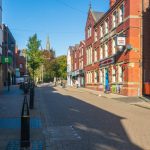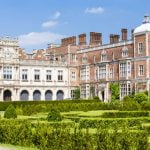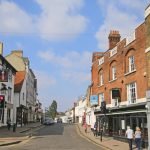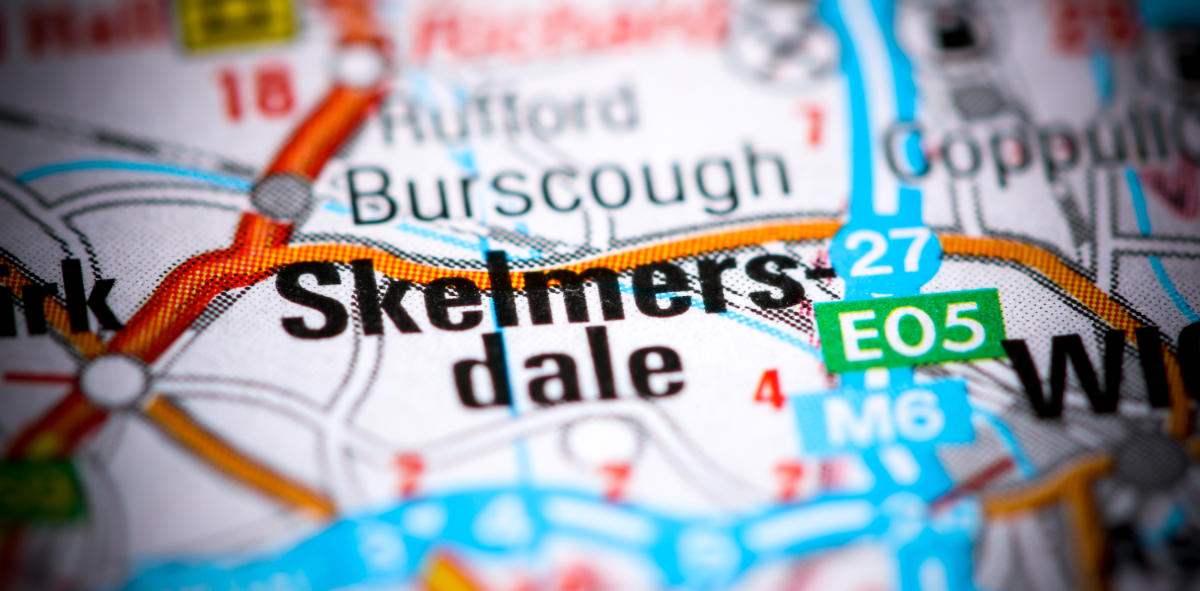
Take a trip to Skem to clear your mind, enjoy good shopping, or see a New Town in action.
Skelmersdale, lovingly known as Skem to the locals, is an ancient town all on its own. According to early records, the town centre exists as far back as the 11th century. We bet when we get stuck into the town’s history, we will findit dates farther back even than that.
Dedicated as a New Town in the 1960s, Skelmersdale has seen a population influx as it soaked up overspill from Liverpool and to a certain degree Manchester. Such towns expanded quicker than the infrastructure would allow. But here, over fifty years later, Skem is going from strength to strength.
Here is what you need to know about this cool Lancashire town before you go to visit.
The Early History of Skelmersdale
Skelmersdale probably saw its first few occupants when the Romans moved into nearby Ribchester. Those ancient armies likely created the roads leading north from most of the big cities. Skelmersdale sits in a position between Liverpool and Ribchester, which would make it ideal for a traveling stop on the road.
Whatever population was here, they didn’t expand quickly. Up until 1851, the town’s population never passed 1,00 people. In those early days, Skelmersdale was not even large enough to become a market town. Picture the town as a quiet, sleepy place to live where the only real industry was agriculture.
Although Lancashire was not yet a county during the times of the Norman Invasion, the towns still existed. Skelmersdale appears as ‘Skjalmar’s Dale’, which means the dale belonging to Skjalmar. Whoever he was, he owned land in the area. He may have been the first landowner to settle here. The name is a blend of Old English and Anglo-Saxon tongues. The officials who took the survey included Skelmersdale in the Hundred of West Derby and in the county of Cheshire.
The town belonged to Uhtred in 1066, but the invading Normans claimed it. The new king gifted the land to his favourite helper: Roger de Poitou, who had multiple parcels of land up and down the country. The Domesday Survey did not record the population of the town at the time. It made an annual income of 2 shillings and 7 pence, which is not a lot for a Lord. It is fair to say that the residents had abandoned the town by then.
Medieval Life on the River Tawd
There are not many records of medieval Skelmersdale. We do know that coal mining came to Lancashire by way of the deep mines in the late 1700s. We also know that Skelmersdale had its own country hall by 1751.
Before that, the Uhtred who owned the land also owned Dalton and Uplitherland. These later passed into the hands of the Gernet family. The Gernets lived in a manor house nearby until 1212, the Henry Travers took over from Roger Gernet. The Gernets became the Dacanes until eventually, the Travers Mesne Manor vanished from the map. Skelmersdale manor went to the Earl of Derby in 1615, whose descendants sold up in 1717. The Ashurst’s bought it, then sold it in 1751 to Sir Thomas Bootle. Since then, it has gone with the title of Earl of Lathom.
Country manors attracted servants; they brought business. They needed forest rangers and firewood, bakers and cooks, and maids and butlers. Small towns would grow up off the estate, just far enough away that the Lords were not annoyed by servants building on their land. Parish churches appeared as the serving folk grew. Skelmersdale slowly but surely returned to life.
It took until 1792, but Skelmersdale opened St Paul’s Church just as soon as they had a large enough parish. Later, when the coal miners came, they came from all over the country. Each new arrival brought a new form of religion. During the height of coal mining in Lancashire in the 1800s, there were 6 different churches in town.
Fun Facts About Skelmersdale
This section of any given tour guide features the best gossip that we can dig up about that area. We have it on good authority that there are those who come here just to scan the gossip column. Here’s what you ought to know about Skelmersdale which will either make it more or less attractive to you:
- Back in 2016, locals came together in protest to stop a landfill site expansion from going ahead in the Whitemoss area.
- 25% of all Lancashire’s businesses have their HQ in Skelmersdale. Why? The post-industrial era and establishment of the New Town meant unemployment was rife come 2000. The local council engaged in large-scale investments in the business sector that worked over time.
- Some of those companies include household names like Walkers crisps and DHL, the package people.
- Skelmersdale had a railway station, and then it didn’t have a railway station, and now there are plans to invest £5 million to have a new station built.
- The biggest roundabout in town has earned the nickname “Hope Island”. It features Gateway Artwork dedicated to cancer sufferers.
- Skelmersdale FC held a record temporarily for drawing the biggest attendance to a football match at Wembley. Their game against Enfield drew 75,000 fans to the stadium, a record for amateur games.
With that sporting note, let’s return to history and find out how the sleepy village of Skelmersdale became the sizable industrial town that we know today.
The Industrial Revolution in Lancashire
The industrial era altered Skelmersdale in a huge way. The town sits right on top of the coal belt that made Lancashire such a rich county back in the 1800s. Landowners snapped up black ground here, hired miners to work it, and made their fortune. The miners, who coughed themselves to death in the mines, had no such fortune. The town received the railway line in 1858 but it later closed in 1956. To begin with, it was the Ormskirk line. This was renamed in 1874. In 1851 there were still only 760 people living in town. The population exploded soon after.
The town had 14 working collieries by 1880. Unfortunately, safety rules were not what they are today. The miners working in these collieries suffered horrible conditions and worked under the constant threat of death. There were more than 100 fatalities before 1900. By the 1930s all were closed. One of the primary landowners was the Earl of Lathom/Derby.
We did manage to find a single picture of one incident dubbed the ‘Tawd Valley Colliery Disaster’. In this case, an explosion underground caused the deep pit to sink, dragging railway, carts, and men, all down into the sunken pit. 2 men died and 1000 men were out of work. The colliery re-opened in 1905. The disaster happened at 4.30 pm on November 20th, 1897. Although most explosions at the time resulted from miners removing the lid of the safety lamp to get more light, this one was caused by the overflowing river. It flooded, trapping gasses, and exploding.
On a slightly happier note, the town’s football club established itself in 1882. The population was 6,627 people at its height in 1891. Almost all the occupants relied on the coal mines for work.
Modern Times in Skelmersdale
By 1901 the town had shrunk to 5,699.
In the years during the wars, children from Liverpool evacuated to Skelmersdale and the surrounding towns. Even though the Germans did not mark the town out for bombing, the people of Skem still contributed to the war effort. They took in children, or they went off to fight. The town council later erected a memorial statue to commemorate those brave souls of WWI and WWII. The statue now sits inside its own memorial garden. There are 116 names recorded, 47 from WWI and 71 from WWII. That’s a lot of men to lose for a town that wasn’t large to begin with.
Towards the 60s, the last of the coal mines were long gone and the UK government was having a population problem in its cities. The answer was to add to the New Towns which they had first come up with back in the 40s. These new, New Towns would soak up city overspill and breath much-needed life into degenerated areas. By the 60s and with the coal mines closed, work had all but dried up here. The government adding thousands of people to the population overnight did nothing to help it. Drug use soared as people fell into poverty. With no work and no prospects, the youth of the town turned to crime.
Beeching Axe
The railway station closed in 1958 as part of the Beeching reports cuts, meaning that those poor souls who had come from the city to live in the countryside now had no way back to the city again. In 1961, the population of the town was only 6,309. Over the next few years, those numbers swelled as high as 30K+ people. Imagine the culture shock for the people who lived there.
The early ’00s saw a massive regeneration project which worked to attract new business into town. The second aim of the investment was to create evening entertainment for those who lived here. With these two tasks completed, Skelmersdale quickly attracted a significant share of Lancashire’s biggest brands. The crime rate dropped, and the overall education level raised. It just goes to show you that money invested in a community is always money well spent.
The council plan to invest £20 million in the Tawd Valley Centre, which they want to bring up to speed as a tourist attraction. Other recent investments lie in the massive Concourse shopping centre, which includes a fun zone for kids and several places to shop, eat, and drink.
The modern town of Skelmersdale is a quiet town where shoppers visit on weekends. It might never have been a medieval market town like some of its neighbours, but it does share that rich industrial heritage that truly marks Lancashire as an educational place to visit. The town is as slow growing as it always was, with that low crime rate and plenty to see and do. These things have brought its population up to over 30k people in recent years.
Famous People from this Area
If you have ever looked at the town of Skelmersdale and wondered if anyone famous was ever born here, we have the answers. Skelmersdale has homegrown a fair few British celebs in its time. Here are some of the Five Minutes Spare favourite famous people from Skelmersdale:
- Lots of footballers train north of Liverpool. There are several from Skelmersdale, including John Anderton, Harry Swainston, Matt Woods, and Leon Osman, who was born in Wigan but raised in Skem.
- Stephen James Bennet, the musician and former frontman of LaHost, lived here.
- Remember 1990s singer Sonia? She was from Skelmersdale.
- Simon tong, from Gorillaz fame, is from here. He was originally a guitarist in the Verve.
- Chess champion John Littlewood was a product of this town.
As you can see, Skelmersdale has a lot of talent for such a slow-growing place. Let’s mop up the last of these categories and move swiftly on to the best attractions in town. Is Skelmersdale a good place to visit? Let’s find out what the locals have to say.
The Best Things to See and Do in Skelmersdale
Loving life on a Lancashire-based holiday? Desperate to find your new favourite place in the world? Here are all the best attractions in Skelmersdale to help get you started.
Historic Sites
There are a few historic sites in Skelmersdale. The town has a total of 21 listed buildings, all of which are Grade II. This is because the town – although ancient – wasn’t large. Many of the listed buildings are farmhouses and their outbuildings. For example, both Felton’s Farmhouse and Felton’s Barn are on the list. The earliest house we know about is the Harsnips farm, which saw constructed in 1667.
The latest of the listed buildings in Skelmersdale (asides from the war monument of 1920) is St Paul’s Church. This lovely old building dates from 1904 and is a family-friendly church that contributes to the local community. You can check on events etc here.
Image via Wikipedia
Landmarks and Points of Interest
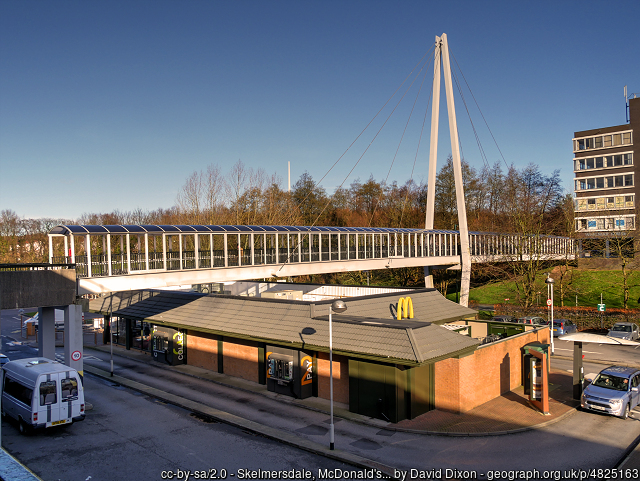
Photo © David Dixon (cc-by-sa/2.0)
The Concourse Bridge bridge above is one of the most recent landmarks in the town. Opened in 2006 to give pedestrian access to the Concourse Centre. There was talk of it being demolished in 2020, however, at the time of writing, it seems to have had a reprieve. I
One of the most comical attractions in town is “the big pipe”. This long pipe cuts through the woodland, covered in generations of graffiti. Locals have campaigned since 2021 to have the pipe added to Google maps, placed on Trip Advisor, and generally turn it into the real local landmark that it deserves to be. Everyone in town knows where the big pipe is. It’s just a big pipe. This local landmark proves that Skem people have kept their sense of humour.
Galleries & Culture
If you head east into the next big town, you will arrive in Wigan. Wigan has great museums and lashings of culture. It plays home to the Love It Gallery, where you can find inspiration, buy fine art, or browse exhibitions. Alternatively, head north to the Millhouse Gallery and see the works of artist James Bartholomew in person.
There is a cinema in town. Head to the Capitol Cinema on a weekend to enjoy a film and get popcorn in your hair. Catch all the latest flicks here and a few retro favourites now and again.
Museums
Unfortunately, Skelmersdale is a bit thin on the ground when it comes to museums. Don’t panic, we’ve got you. Instead, head to nearby Trencherfield and visit the mill engine that they have there. Situated in Wigan on the Leeds and Liverpool Canal, this mill once produced cotton for the masses of England. The mill sports a steam engine that is over 100 years old and counting. The massive mill engine produces 2,500 horsepower when turned. They are only open for selected dates so plan your visit in advance.
While you are in Wigan, stop by the Museum of Wigan Life. It’s a specialty and niche museum that focuses on living in this area of Lancashire during the industrial era. You will learn a lot about the miners and weavers of the time.
Sports and Teams
There are two golf clubs within striking distance of Skelmersdale. Check out the Beacon Park Golf Club which has 18 holes and a professional shop. You can go to the Dean Wood golf course to the south and east of town if you fancy a change. The latter is a serene country village club with lovely greens over rolling hills. Their course came from the imagination of James Braid.
The local FC is Skelmersdale United F.C. and they play in the Northern Premier League. The team formed back in the 1800s, not long after the beautiful game arrived.
If you are a rugby fan, you can choose between RUFC Upholland to the north or the old Ormskirk Rugby Club.
There is a Bannatyne Health Club in the area for those looking for a gym. It is the Bannatyne brand though, so don’t expect to land a bargain. The building features innovative gym equipment coupled with an excellent pool.
Other Outdoor Attractions in Skelmersdale
The biggest attraction in and around Skelmersdale is Beacon Country Park. This park features 300 acres of outstanding natural beauty. It is a Green-Flag award-winning park that has its own golf course and pro shop, tours, walks, hikes, countryside displays, exhibitions, the occasional market, events including carnivals and fairground rides, and a whole lot more. This park is a favourite among both tourists and locals.
Another great outdoor area is Tawd Valley Park. The difference between the two is that this one has the river cutting through it. If you want somewhere to cool off in summer, this is the park you choose. This park is more like a twisting path through a woodland that borders the river. It takes you from the middle of town all the way to Cobbs Clough Brow. The area favours dog walkers and Sunday strolls.
If you want a woodland that people use a little less, head to Westhead’s Clough. This area of natural woodland has wildlife to spot and trees to get lost in. Go explore.
Shopping and Retail
If you want to shop in Skelmersdale, you go to the Concourse Shopping Centre. The Concourse has almost 100 shops to choose from. It has a kiddie’s fun zone and all the cafes you can ask for. It’s where the teenagers go to hang out on the weekend. Skelmersdale has plenty of shops, including Peacocks, a B & M, and a Poundworld. What else do you need?
Where to Eat and Drink?
If you want to try some pub grub in Skelmersdale, then you have plenty of options. The Miner’s Peg is a good start, as is The Mount. The kids hang out at Flavour’s Café, where they can get cool drinks. There’s the Fortuna for a good Chinese meal and The Venture has an American snack-style menu.
Other Notable Nearby Attractions
There are so many more things to see and do in the rest of Lancashire that tourists are often surprised. The mid-north might be colder than the south, but the people extend a warm welcome and there are always things to keep visitors amused. Here are other places to visit if you are taking a holiday in Lancashire:
- Shop in the ancient market town of Poulton-le-Fylde
- Go visit Pendle Hill and nearby Nelson
- Visit Darwen to learn about the former textile industry here
- If you’d prefer to learn about cotton and coal, then check out Leyland
- Go to Clitheroe if you want to explore a castle
- Have an adventure based in Pendle Forest with a trip to Burnley
- Head for the city and experience the epic history of the county
Five Minutes Spare
If you enjoyed this article and wouldn’t mind seeing more fun UK travel guides float across your feed, then we would be delighted to accommodate. Simply click this link and drop us a like to follow us on Facebook. Otherwise, check out our other


